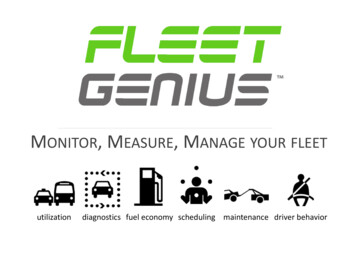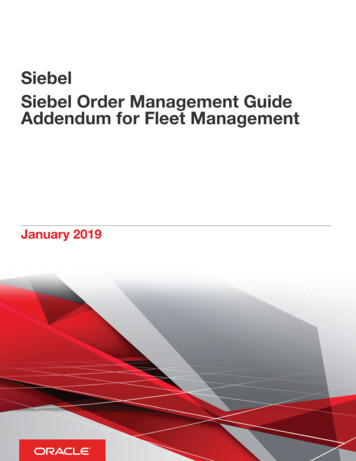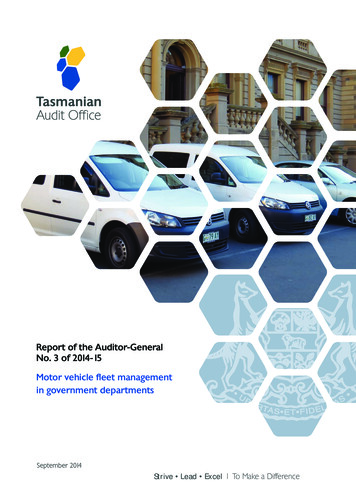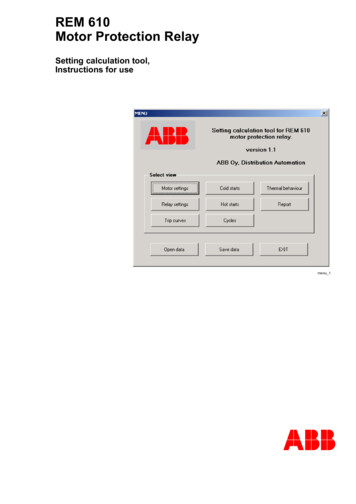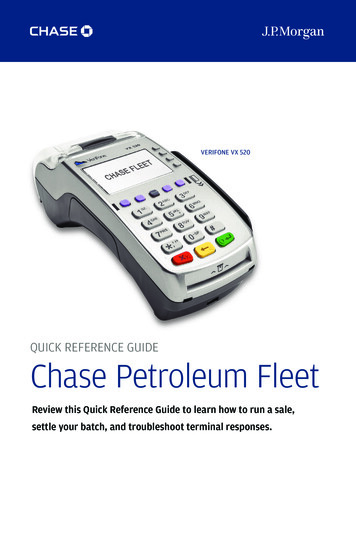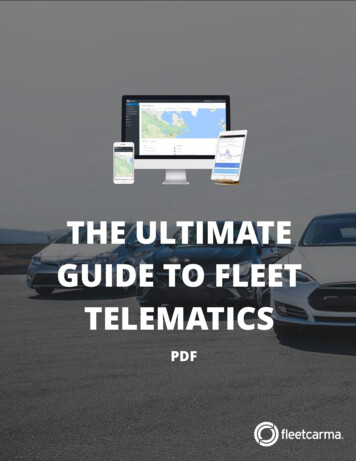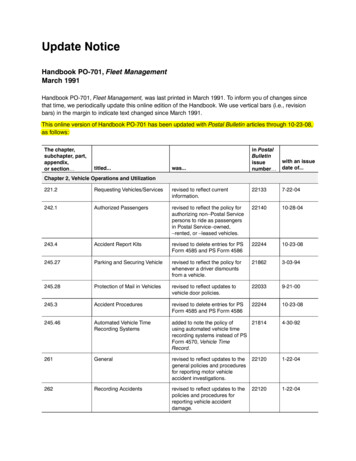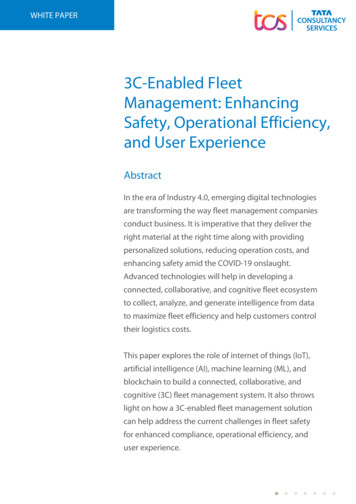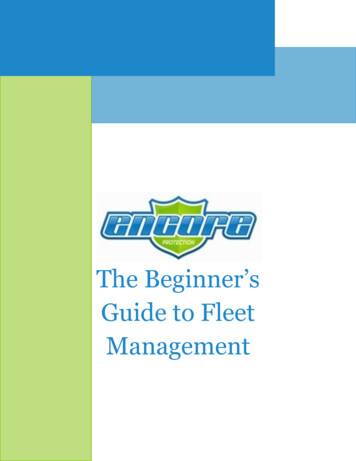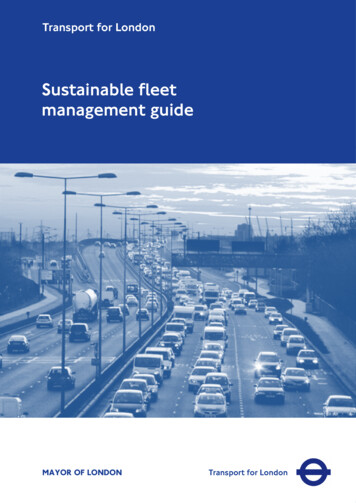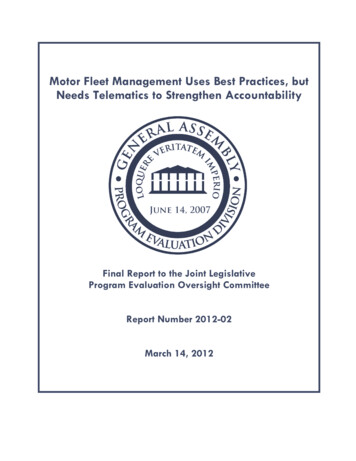
Transcription
Motor Fleet Management Uses Best Practices, butNeeds Telematics to Strengthen AccountabilityFinal Report to the Joint LegislativeProgram Evaluation Oversight CommitteeReport Number 2012-02March 14, 2012
PROGRRAM EVALUAATIONN DIVISSIONNORTH CAROLINAAA GENERAAL ASSEMMBLYMarcch 2012Report NNo. 2012-02Mootor Fleet Manageement Uses BBest Practicess, but NNeedssTeelematiics to StrengtSthen AccountAtabilityySummmaryThe General Asssembly directed the Proogram Evaluuation Divisiion tostudy all passennger and non-passengeer vehicles owned and ooperatedby state government agenc ies and insttitutions. Thiss second in a series ofthreee reports evaaluates the mmanagementt of passenger vehicles bby theDepaartment of AdministratioAn’s Division oof Motor Fleeet Managemment.The Division of Motor Fleet Managemeent received a “B ” forcompliance withh most fleet managemeent best pracctices, but fleeetnagement annd accounta bility can bee improved. The Divisionn’s reliancemanon sttate agenciees for managgement and ooversight maakes it difficuult to holdagenncies accounttable. The DDivision does not have suffficient informmation todeteermine the rigght number oof passengerr vehicles forr state goverrnmentneedds. State laww directs the division to determine vehhicle utilization forassiggned vehicless based onlyy on mileagee, but frequeency of use aand vehiclepurppose are alsoo necessary ffor a compleete assessmeent of vehiclee utilization.Curtaailment of veehicle replaccement in reccent years haas led to an older,moree costly, and less reliablee fleet. Recent changes to the rate sttructuremay also limit funding for veehicle replaceement.Telematics offerrs a cost-effeective solution to improove accountaability andprovvide complette vehicle uttilization infformation. BBy integrating wirelesscommmunications, vehicle moniitoring systemms, and location devices,, telematicsprovvides complete vehicle ut ilization data, identifies and confirmms misuse,reduuces reliance on state ag encies, and ppromotes moore efficient vehicleutilizzation. Cost estimatesesugggest implemmentation of basic telemaaticsserviices could bee cost effectiive due to esstimated redductions in veehicleutilizzation.Throough technollogy and maanagement improvemeents, the Division ofMotoor Fleet Mannagement caan continue to meet statte governmeent needsfor passengerptransportationn services. TTo address the identifiedd issues,several recommeendations sugggest action by the Geneeral Assembly. First, tostrenngthen accouuntability forr state-ownedd passengerr vehicles, thee Division ofMotoor Fleet Mannagement shoould be direected to phasse in implementation oftelemmatics. Seconnd, the Divisi on of Motor Fleet Management shouuld bedireccted to improove manageement practicces identifiedd in this repoort. Third,the GeneralGAsseembly shouldd modify thee statutory mileage threshhold forstatee-owned passsenger vehiccles in N.C. GGen. Stat. § 143-341(8).i.7a bydireccting the Deppartment of Administratioon to adopt rules establiishing apassenger vehicle threshold ccriterion thatt includes mileage, frequuency ofuse, and vehicle purpose.
Motor Fleet ManagementPurpose andScopeReport No. 2012-02The 2011–12 work plan of the Joint Legislative Program EvaluationOversight Committee directed the Program Evaluation Division to study theefficiency and effectiveness of the state’s motor fleet operations in theDepartment of Administration’s Division of Motor Fleet Management. TheGeneral Assembly broadened the scope of the project to include allpassenger and non-passenger vehicles owned and operated by all Stategovernment departments, institutions, and entities, and to include motorfleet fees and associated cash balances, mechanic operations, the use andpurpose of assigned vehicles, and state fueling stations.1 The legislationalso directed a follow-up study on the formation of an AviationManagement Authority.2For the purpose of this evaluation, state-owned motor vehicles weredefined as licensed highway-use vehicles purchased or leased by stateagencies and institutions for any purpose. Trailers, non-highway-usevehicles, and motorized equipment were excluded. Four research questionsguided the inquiry.1. How many state-owned vehicles does North Carolina have, andwhat are their purposes?2. How does North Carolina ensure state-owned vehicles aremanaged according to fleet management best practices?3. Does North Carolina have the appropriate number and mix ofstate-owned vehicles to meet state government needs?4. What alternatives exist for state government oversight, operation,and ownership of vehicles?This report is the second in a series of three reports on the status of stateowned motor vehicles in North Carolina, and focuses on the management ofpassenger vehicles by the Department of Administration’s Motor FleetManagement Division. The first report, Inadequate Data and FleetInformation Management Weaken Accountability for North Carolina’sVehicles, provided an overview of the number, use, and cost of motorvehicles across all agencies and institutions. The third report describes themanagement of other vehicles owned by state agencies and institutions.The following data were collected for this report: North Carolina statutes and administrative rules; fleet management practices of the Division of Motor FleetManagement from a survey of fleet managers; literature review of fleet management best practices; interviews with Department of Administration and Division of MotorFleet Management staff; analysis of fleet management information from the Division ofMotor Fleet Management’s information system for Fiscal Year2008–09, Fiscal Year 2009–10, and Fiscal Year 2010–11; analysis of expenditures, revenues, and cash balances for theDivision of Motor Fleet Management;2011 NC Sess. Laws, 2011-145, Section 6.13. (d)-(e)Program Evaluation Division. (2010, April). Selling 25 Underutilized Aircraft May Yield Up to 8.1 Million and Save 1.5 MillionAnnually. Raleigh, NC: General Assembly.12Page 2 of 30
Motor Fleet ManagementReport No. 2012-02 Backgroundfocus groups with vehicle coordinators from state agencies andinstitutions;surveys of state employees who use state-owned passengervehicles;cost information from a rental car agency operating in NorthCarolina;cost information from a telematics service provider;audits and evaluations of state-owned motor vehicles in otherstates; andinterviews with and documents from fleet managementadministrators in other states.North Carolina established the Division of Motor Fleet Management toensure the proper management of state-owned passenger vehicles. In1981, the General Assembly directed the Department of Administration tocentrally manage state-owned vehicles. The Department of Administrationestablished the Division of Motor Fleet Management (MFM) to manage,acquire, maintain, repair, and store state-owned passenger vehicles, andcharged MFM with enforcing state policy on vehicle use, assignment, andcommuting. This mandate to centralize passenger transportation requiredstate agencies and institutions to transfer ownership, custody, or control ofall passenger vehicles to MFM except vehicles used primarily for lawenforcement, fire, and emergency purposes.3 Passenger vehicles aredefined by administrative rule as any automobile sedan, station wagon,pick-up truck, four-wheel-drive utility vehicle, or passenger-type minivan.Vehicles performing functions other than passenger transport are excludedfrom centralized oversight by MFM.The Department of Administration’s regulations for motor fleetmanagement establish the mission for MFM.Motor Fleet Management provides safe and efficient management,maintenance, repair, and storage of state-owned passenger motorvehicles. Motor Fleet Management provides savings to taxpayers ofNorth Carolina by supplying a centralized source of passengertransportation for all state agencies and to all state employees in theperformance of their official duties in the most cost-effective way.4To meet this mission, MFM oversees the use of state-owned passengervehicles through rules and policies governing vehicle assignment andtermination, rates and billing, fleet operations and services, maintenanceand care of vehicles, and vehicle usage.At the end of Fiscal Year 2010–11, MFM had 7,874 vehicles in its fleet.Exhibit 1 shows the number of vehicles by body type. Sedans, minivans,and sport-utility vehicles represent most of the vehicles in MFM’s fleet.3 State law specifically exempts passenger vehicles from this requirement if they are under the ownership, custody, or control of theHighway Patrol, the State Bureau of Investigation, or Butner Public Safety, which are used primarily for law enforcement, fire, oremergency purposes.4 North Carolina Department of Administration (2010). Motor Fleet Management Regulations, p. 1.Page 3 of 30
Motor Fleet ManagementReport No. 2012-02Exhibit 1Other Vehicles175(2%)Minivans1,357(17%)63% of MFM’s Fleet inFiscal Year 2010–11Were 3%)Total MFM Vehicles 7,874Note: Other Vehicles includes passenger vans, pickup trucks, a wrecker, and a bus.Source: Program Evaluation Division based on MFM data.Exhibit 293% of MFMPassenger VehiclesWere Assigned toIndividuals orAgenciesMotor PoolVehicles282(4%)Assigned ssigned toAgencies3,625(46%)UnassignedVehicles254(3%)Total MFM Vehicles 7,874Note: Unassigned Vehicles were pending assignment, needing major repairs, waiting fordisposal, or were being used for recycled parts.Source: Program Evaluation Division based on MFM data.MFM vehicles can be assigned to individuals or agencies or used in thestate motor pool. Exhibit 2 shows that 93% of MFM’s vehicles wereassigned to individuals and agencies. Assigned vehicles. State employees may be assigned a stateowned passenger vehicle for official state business when the vehicleis expected to be driven a minimum of 3,150 miles per quarter.State agencies or institutions may be assigned a state-ownedpassenger vehicle when the vehicle is expected to be driven anaverage of 1,050 miles per month to conduct official state businessPage 4 of 30
Motor Fleet ManagementReport No. 2012-02or for a minimum number of low-mileage trips per month asdetermined by the agency and approved by MFM. Agencyassigned vehicles cannot be consistently driven by one employeeand must be regularly available to all agency personnel. Motor pool vehicles. MFM offers state-owned passenger vehiclesfor short-term assignment to state employees. These vehicles arecentrally controlled and housed at their facility in Raleigh.During Fiscal Year 2010–11, MFM assigned 7,338 vehicles to 45 stateagencies and institutions, 19 community colleges, 4 state boards andcommissions, and 2 state authorities. The Department of Correction had thegreatest number with 2,379 vehicles and 8 state entities were assignedonly one vehicle.5 The appendix shows the number of vehicles assigned toeach state agency by assignment type.The MFM facility in Wake County houses administrative offices,maintenance garage, parts department, motor pool, and storage forvehicles awaiting maintenance or assignment. Exhibit 3 describes MFM’sorganization and the activities performed by each unit.Exhibit 3: Division of Motor Fleet Management Organizational StructureSource: Program Evaluation Division based on Division of Motor Fleet Management’s organizational chart and information on each unit.The eight state entities assigned one vehicle are Bladen, Johnston, Richmond, Surry and Wilson Community Colleges; North CarolinaGlobal TransPark Authority; North Carolina State Board of Elections; and Office of the State Controller.5Page 5 of 30
Motor Fleet ManagementReport No. 2012-02MFM is funded through an internal service fund and does not receivedirect state appropriations.6 Exhibit 4 describes how the internal servicefund supports the full cost of MFM operations.Exhibit 4: An Internal Service Fund Supports Full Cost of MFM OperationsSource: Program Evaluation Division based on Division of Motor Fleet Management information and the budget manual from the Office ofState Budget and Management.Exhibit 5 shows that the MFM internal service fund has maintained apositive year-end cash balance during the last ten fiscal years. From FiscalYear 2001–02 through Fiscal Year 2007–08, year-end cash balancesranged from 5 million to 16 million, but year-end cash balances grew inFiscal Year 2008–09 and Fiscal Year 2009–10.Internal service funds account for any activity providing goods and services to other state governmental agencies and institutions on acost-reimbursement basis. Internal service funds do not revert unexpended funds at the end of each fiscal year.6Page 6 of 30
Motor Fleet ManagementReport No. 2012-02MFM Internal ServiceFund Year-End CashBalances for FiscalYear 2001–02 throughFiscal Year 2010–11MillionsExhibit 5 50 45 40 35 30 25 20 15 10 5 0 47,353,624 16,663,222Fiscal YearSource: Program Evaluation Division based on year-end budget reports for the MFM internalservice fund.According to the Department of Administration, several factors contributedto the increase in the year-end cash balance between Fiscal Year 2007–08 and Fiscal Year 2009–10: Vehicle acquisition. MFM bought fewer vehicles in Fiscal Year2007–08 and Fiscal Year 2008–09, and bought no vehicles inFiscal Year 2009–10, which reduced expenditures. MFM rates. MFM increased the mileage reimbursement rate byeight cents per mile in July 2008 to respond to increased motor fueland other operating costs. The mileage reimbursement ratedecreased by three cents per mile in May 2010. Travel restrictions. State employee travel was restricted from April2009 through June 2010. MFM operating expenditures for motorfuel and maintenance decreased during this time because vehicleuse was limited. Even though state employees traveled less, stateagencies with assigned vehicles continued to pay MFM fees for the1,050-mile monthly minimum.After the cash balance for the MFM internal service fund reached 47.4million at the end of Fiscal Year 2009–10, the Governor and the GeneralAssembly directed the Department of Administration to transfer 64 millionfrom the MFM internal service fund to the General Fund during Fiscal Year2009–10 and Fiscal Year 2010–11. These transfers to the General Fundhelped balance the state budget and required MFM to pay 16.9 millionin rebates to state agencies and institutions that had used federal fundsand departmental receipts for MFM services. Exhibit 6 provides a summaryof the budget transfers and rebates by fiscal year.Page 7 of 30
Motor Fleet ManagementExhibit 6MFM Internal ServiceFund TransfersTotaled 80.9 Million inFiscal Years 2009–10and 2010–11Report No. 2012-02Budget Transfers and RebatesGovernorFiscal Year2009–10 20,000,000 816,925,343 27,397,325 53,528,018 80,925,343Rebates to State Agencies Total Transfers—General AssemblyTotal TransfersFiscal Year2010–11Source: Program Evaluation Division based on year-end budget reports for the MFM internalservice fund and budget legislation and reports for Fiscal Year 2010–11.After the transfers and rebates, the year-end cash balance for the MFMinternal service fund decreased to 16.7 million for Fiscal Year 2010–11.MFM operating expenditures cover administration, facilities, insurance,maintenance and repairs, and motor fuel. Exhibit 7 shows MFM spent 26.5 million during Fiscal Year 2010–11 for operations, including 48administrative and maintenance positions.7 Motor fuel, at 53% ofexpenditures, was the largest cost category (see Exhibit 7).Exhibit 753% of MFM Expendituresin Fiscal Year 2010–11Paid for Motor FuelAdministration 2,196,103(8%)Facilities 211,539(1%)VehiclePurchases 2,185,173(8%)Repairs &Maintenance 6,680,254(25%)Motor Fuel 13,873,571(53%)Insurance 1,350,169(5%)Total Expenditures 26,496,809Source: Program Evaluation Division based on Fiscal Year 2010–11 year-end budget reportfor the MFM internal service fund.Centralized management of state-owned passenger vehicles isbeneficial to North Carolina state government. Evaluations of motorvehicles and fleet operations in other states have found decentralizedmanagement of passenger vehicles increased inefficiencies and costs.Evaluators in these states recommended centralized management of7As of January 2012, MFM had 48 positions with 34 permanent employees, 10 temporary employees, and 4 vacancies.Page 8 of 30
Motor Fleet ManagementReport No. 2012-02vehicles to improve efficiencies. Though North Carolina centralized themanagement of state-owned passenger vehicles 30 years ago, advancesin fleet technology and business practices in recent years may offeropportunities for MFM to improve its management.FindingsFinding 1. With the exception of tracking complete vehicle utilizationinformation for assigned vehicles, the Division of Motor FleetManagement is operating in accordance with fleet management bestpractices.The United States General Services Administration has been providing fleetmanagement services to federal agencies since 1954 and providesguidelines on motor fleet management best practices. The ProgramEvaluation Division reviewed these federal guidelines and other sources toidentify four categories of fleet management best practices.8 Policies and Procedures. Written documentation of policies andprocedures protects the users of passenger transportation vehicles.Written policies and procedures provide controls to ensure vehicles areused appropriately and users of state vehicles are held accountable. Management of Vehicle Utilization Data. Vehicle utilization is anindicator of the business need for a vehicle and is tracked throughvehicle mileage and frequency of use.9 Collecting data on vehiclemileage and frequency of use can be done by tracking miles driven pertrip or monthly miles in combination with the number of trips. The mostefficient means of tracking utilization data is through an electronic fleetmanagement information system. Financial Management. Implementation of a cost recovery system is afinancial management best practice. A cost recovery system allows afleet manager to identify, monitor, evaluate, and adjust fleet ownership,operating, and management costs. With this system, users budget andpay for vehicles and their related services and resources based on anassessment of the direct (depreciation, fuel, maintenance, and insurance)and indirect (administration, maintenance personnel, and operatingoverhead) costs associated with managing and maintaining thepassenger transportation fleet. Vehicle replacement and acquisition. Developing a fleet replacementplan based on appropriate guidelines is another important bestpractice. Plans should be updated annually with projected replacementdates and a cost for each vehicle. Organizations using fleetmanagement best practices purchase standardized vehicle types involume to reduce acquisition costs.The Division of Motor Fleet Management (MFM) is in compliance withstate law and with most fleet management best practices. The ProgramEvaluation Division survey of North Carolina state government fleet8 The Program Evaluation Division reviewed multiple sources including federal guidelines that were adopted from the United StatesGeneral Services Administration, which provides fleet management services to federal agencies.9 Program Evaluation Division. (2011, December). Inadequate Data and Fleet Information Management Weaken Accountability for NorthCarolina’s Vehicles. Raleigh, NC General AssemblyPage 9 of 30
Motor Fleet ManagementReport No. 2012-02managers asked how MFM operated across the four best-practicecategories. MFM’s scores were based on implementation criteria across thefour best-practice categories for their entire fleet of assigned and motorpool vehicles. MFM administers passenger vehicle services in accordancewith most fleet management industry best practices; however, the divisionwould benefit from tracking complete vehicle utilization data for assignedvehicles. Exhibit 8 summarizes how MFM performed across the four fleetmanagement best practice categories.Page 10 of 30
Motor Fleet ManagementReport No. 2012-02Exhibit 8: MFM Received a B for Complying with Most Fleet Management Best PracticesFleet ManagementBest PracticeCategoryWritten Policiesand ProceduresManagement ofVehicle nt andAcquisitionDivision ofMotor FleetManagement’sResponseEvaluation CriteriaThe division has written policies for who can use vehicles; how vehicles can be used; when vehicles can be used; vehicle acquisition; vehicle disposal; and vehicle maintenance.The division manages an electronic fleet management information system.The division collects vehicle mileage and frequency of use on aper vehicle basis for their entire fleet through tracking per trip mile; or tracking monthly miles and daily trip counts.The division has a cost recovery system in placeThe division tracks direct and indirect costs for maintenance and repair (including parts and labor); fuel; depreciation for owned vehicles; insurance; services and benefits, official travel and transportation, of allfleet management personnel (including fleet manager,mechanical and administrative personnel); purchasing operating equipment for fleet managementactivities (e.g., office supplies); and servicing and repairing operating equipment.The division has a vehicle replacement plan; updates the replacement plan annually; purchases vehicles in volume; and purchases standardized types of vehicles.Yes Yes Yes Percentageof CriteriaMetGrade6 of 6or100%A 1 of 2or50%F8 of 8or100%A 4 of 4or100%A 88%B NoNo a bNo Yes NoOverall Division Grade(a) The Division of Motor Fleet Management does not track per-trip miles for the entire fleet. Per-trip miles are tracked only for motorpool vehicles, and monthly mileage is tracked for assigned vehicles.(b) State agencies are required to maintain paper trip logs for assigned vehicles, but the Division of Motor Fleet Management does notcollect per-trip information from the logs.Source: Program Evaluation Division based on the fleet management best practice survey and interviews.Page 11 of 30
Motor Fleet ManagementReport No. 2012-02Finding 2. The Division of Motor Fleet Management’s delegation of fleetmanagement and oversight to state agencies hampers its ability to holdagencies accountable, but advances in technology offer opportunities toimprove accountability.State law authorizes the Division of Motor Fleet Management (MFM) todelegate enforcement of MFM rules regulating the use of state-ownedpassenger vehicles to state agencies. MFM has delegated much of the dayto-day oversight and management of its vehicles to state agencies becauseit does not have the staff resources to directly oversee the thousands ofvehicles deployed throughout North Carolina. State agencies are expectedto coordinate vehicle usage, investigate misuse claims, and obtainpreventive maintenance.Beginning in July 2010, MFM required each agency and institution todesignate a vehicle coordinator to serve as a liaison to MFM. Prior to thedesignation of vehicle coordinators, MFM dealt directly with over 3,700drivers or individuals assigned a passenger vehicle. MFM created thecoordinator role to have one contact for each agency, to reduce thenumber of people with whom the division was interacting, and to increaseagencies’ management responsibility for vehicles.Vehicle coordinators are responsible for submitting requests for assigned vehicles; reviewing monthly mileage reports and daily travel logs; ensuring monthly mileage reports are submitted in a timely manner; reporting changes in vehicle assignments within the agency; initiating review of underutilized vehicles and reallocating vehicleswithin the agency; recommending vehicles for exemption from the minimum mileagerequirement; and ensuring the return of vehicles in a timely manner when requestedby MFM.The magnitude of the vehicle coordinator’s responsibility varies dependingon how many MFM vehicles are assigned to a state agency or institution.MFM staff stated that once a vehicle is assigned to an individual oragency, they are aware of the miles driven, but not the driver of thevehicle or the exact purpose unless the agency reports changes inassignment and purpose. MFM relies on the vehicle coordinator to ensuremonthly mileage is submitted, but MFM does not conduct independentaudits of paper logs for each vehicle to ensure vehicle mileage is correct orthe vehicle is being used for its intended purpose.Establishing vehicle coordinators has created efficiencies for MFM, butthe division needs to provide more guidance to vehicle coordinators ontheir role and responsibilities. Vehicle coordinators received initialtraining, but MFM has not repeated the training or conducted anyadditional training. The MFM website has “Frequently Asked Questions”with responses for vehicle coordinators, and MFM regulations are availableonline, but no training information is available online. Data from focusgroups with coordinators indicated each coordinator saw their roledifferently and the oversight of vehicles varied. For example, somePage 12 of 30
Motor Fleet ManagementReport No. 2012-02coordinators stated that their main responsibility was to ensure mileagelogs were entered on time whereas others stated that they also reviewutilization reports, coordinate maintenance, and talked with MFM staffdaily. During focus group discussions, the Program Evaluation Divisionobserved that vehicle coordinators were eager to talk about theirresponsibilities and share ideas. Because MFM has not offered follow-uptraining, vehicle coordinators have not had an opportunity to meet witheach other or MFM staff to discuss ideas or concerns about theirresponsibilities.MFM does not routinely conduct customer satisfaction surveys. Surveysprovide a way for MFM to interact with its customers, learn about concerns,and point out process improvements. The Department of Administrationsurveyed MFM customers as a part of the agency strategic planningprocess in 2009, but MFM does not regularly survey state employees usingtheir vehicles and does not have information to measure outcomes overtime. Because MFM does not regularly conduct customer satisfactionsurveys, the Program Evaluation Division surveyed individuals who have avehicle assigned to them as well as individuals who used a motor poolvehicle between July 1 and September 30, 2011.Over 1,500 state employees with assigned vehicles and 246 stateemployees who used motor pool vehicles responded to the survey.10 TheProgram Evaluation Division found that the majority (over 60% in everycategory) of state employees with assigned vehicles were satisfied withtheir vehicles. However, some state employees expressed dissatisfactionwith the reliability (16%), condition (18%), and type of vehicle they hadbeen assigned (19%). This lack of satisfaction is echoed throughout theopen-ended comments. Similarly, the majority (over 70% in everycategory) of motor pool users reported satisfaction with MFM services andvehicles, but some users were dissatisfied with the cleanliness (14%),reliability (13%), and driving condition (13%) of vehicles.MFM does not independently investigate reports of vehicle misuse.MFM is responsible for verifying whether vehicle misuse has occurred andtaking appropriate action. MFM relies on state agencies to handle reportsreceived on its misuse hotline and website.11 Each state agency is requiredto designate a misuse coordinator to receive misuse complaints. MFM hasdeveloped materials for misuse coordinators explaining MFM policyregarding use and misuse of state-owned passenger vehicles.During the past two years, MFM received an estimated 2,043 misusereports.12 When MFM receives a complaint or misuse report for an MFMvehicle providing enough information to identify a specific vehicle, MFMdetermines the vehicle assignment and sends the misuse coordinator areport describing the complaint. The agency is responsible for investigatingeach compliant, and the misuse coordinator has 10 days to respond. MFMOver 3,700 state employees have assigned vehicles. Although the Program Evaluation Division does not know exactly how manystate employees with assigned vehicles had access to the survey, the estimated response rate was 42%. Also, 531 state employees whohad used a motor pool vehicle between July 1, 2011–September 30, 2011 received a survey with a response rate of 46%.11 The hotline and website were established for citizens to report improper use of state vehicles.12 Most of the misuse reports were related to MFM vehicles, but about 8% of the total reports were for vehicles belonging to otherstate agencies or other entities authorized to have permanent state license plates.10Page 13 of 30
Motor Fleet ManagementReport No. 2012-02officials said that agencies have their own rules and policies regardingmisuse of state vehicles and the level of investigation and disciplinaryaction vary. For example, the Division of Emergency Management has ano-tolerance misuse policy and has stated in response to complaints thatdrivers have had vehicle privileges suspended. MFM does not compileinformation describing agency responses to misuse complaints.MFM assures agencies respond to misuse allegations, but does notindependently verify that agencies fully investigate the complaint and takeappropriate action.13 State law authorizes the Department ofAdministration to revoke assignment of a state-owned passenger vehicle ifmisuse is verified, but state agencies can appeal the decision.14 MFMofficials indicated that the division terminates the assignment of vehicleseither on a temporary or permanent basis in cases of driving whileimpaired, driving without a valid driver’s licens
Mar 14, 2012 · Motor Fleet Management Uses Best Practices, but Needs Telematics to Strengthen Accountability . cted the Pro n-passenge ies and inst anagement n’s Division o Manageme manageme bility can be ement and o Division does f passenger division to d on mile
